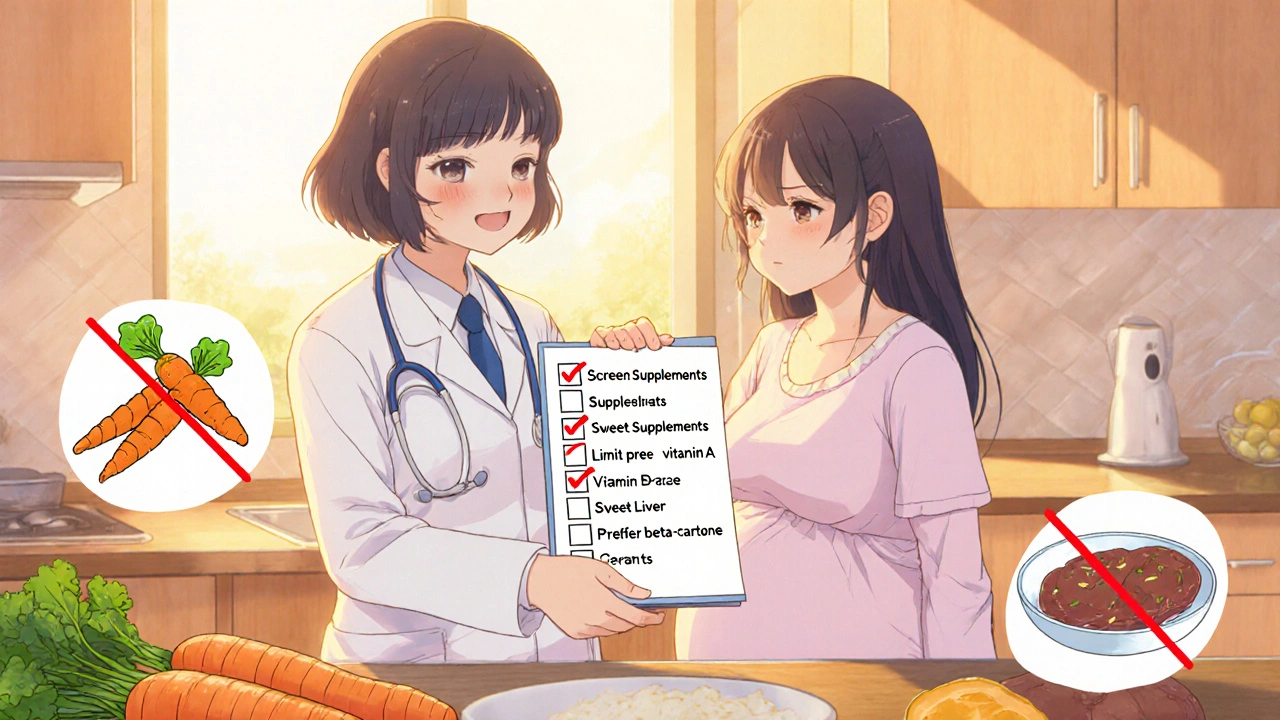Vitamin A Intake Calculator for Pregnancy
Calculate Your Safe Vitamin A Intake
This calculator helps you determine if your daily pre-formed vitamin A intake is within safe limits for pregnancy (below 10,000 IU/day).
Safe Intake (Below 10,000 IU)
Your total vitamin A intake is within safe limits for pregnancy. However, always consult your healthcare provider for personalized advice.
Caution Needed
Your intake exceeds 7,500 IU/day, which is approaching the upper limit. Consider reducing sources of pre-formed vitamin A.
Unsafe Intake (Above 10,000 IU)
Your total vitamin A intake exceeds the safe limit for pregnancy. This could increase teratogenic risk for developing fetuses. Please consult your healthcare provider immediately.
Important Notes
Pre-formed vitamin A (retinol, retinyl esters) should not exceed 10,000 IU/day during pregnancy. Beta-carotene and other provitamin A sources are generally safe.
Most prenatal vitamins contain 2,500-5,000 IU of pre-formed vitamin A, which is within the safe range.
One 3-oz serving of beef liver contains over 27,000 IU of vitamin A.
When you hear the words “retinoids” or “vitamin A,” you probably think of clear skin, good night vision, or a healthy immune system. Yet the same compounds that keep you looking fresh can wreak havoc on a developing fetus if the dose is too high. This guide untangles the science, shows which forms are safe, and gives clinicians practical steps to keep patients protected.
Quick Takeaways
- Retinoids teratogenicity
- Pre‑formed vitamin A (retinol, retinyl esters) becomes risky above 10,000 IU / day for pregnant women.
- Beta‑carotene, a provitamin A, poses virtually no teratogenic risk because conversion to active vitamin A is tightly regulated.
- Topical retinoids deliver minimal systemic exposure, but most guidelines still advise avoidance during pregnancy.
- Effective risk management-iPLEDGE, contraception counseling, and supplement review-drastically cuts unintended exposures.
What Are Retinoids and Vitamin A?
Retinoids are a family of compounds that include natural vitamin A (retinol, retinaldehyde, retinyl esters) and synthetic analogs such as isotretinoin and etretinate. They bind to nuclear retinoic‑acid receptors (RARs) and retinoid‑X receptors (RXRs), regulating gene transcription essential for cell growth, differentiation, and embryonic patterning.
Vitamin A refers primarily to pre‑formed retinol and its esterified forms, while provitamin A carotenoids like beta‑carotene are converted in the body as needed. Both categories support vision, immune function, and skin health, but their pharmacokinetics differ dramatically.
Why Excess Vitamin A Becomes a Teratogen
The first clue came from Sidney Q. Cohlan’s 1953 rat study, where daily intake of 35,000 IU of natural vitamin A caused eye defects, cleft palate, and exencephaly in offspring. Human data confirm the same vulnerability, especially during weeks 3‑5 of gestation-the peak of organogenesis.
Mechanistically, high retinoid levels disrupt neural crest cells, which give rise to facial bones, cardiac structures, and peripheral nerves. Retinoids also alter expression of key homeobox genes, notably Hoxb‑1, deranging axial patterning. The result: a spectrum of craniofacial, cardiac, and central‑nervous‑system malformations.
Form‑by‑Form Risk Profile
| Compound | Typical Dose (Therapeutic) | Teratogenic Threshold | Half‑life | Pregnancy Category |
|---|---|---|---|---|
| Pre‑formed retinol (dietary) | 5,000-10,000 IU / day | >10,000 IU / day | 120-180 days (stored in liver) | FDA C |
| Beta‑carotene (provitamin) | 300,000 IU equiv. | No documented threshold | Metabolized as needed | Generally safe |
| Isotretinoin (Accutane®) | 0.5-1 mg / kg / day | 0.5 mg / kg / day | 18-24 h | Category X |
| Etretinate (Tigason®) | 10 mg / day | 10 mg / day | ≈120 days | Category X |
| Tretinoin (topical) | 0.05‑0.1 % cream | Minimal systemic absorption | Negligible | Category C |
The table makes two points clear: synthetic oral retinoids are dramatically more potent teratogens than natural vitamin A, and beta‑carotene is essentially non‑teratogenic.

Clinical Evidence of Harm
Modern surveillance confirms Cohlan’s animal work. The FDA’s iPLEDGE program (2022 data) shows isotretinoin exposure leads to major congenital malformations in 20‑35% of first‑trimester pregnancies-about a 25‑fold increase over the baseline 2‑3% rate. A 1995 cohort (Rothman et al.) linked maternal intakes >10,000 IU / day to a 2.4‑fold rise in birth defects.
Even without prescription drugs, the National Birth Defects Prevention Network notes that 15‑20% of vitamin‑A‑related defects arise from over‑the‑counter supplements or liver‑rich foods. One Reddit user recounted an accidental pregnancy three weeks after finishing a standard isotretinoin cycle, ending in a termination due to documented craniofacial risk.
Guidelines for Health‑Care Professionals
Professional societies converge on a simple rule: keep pre‑formed vitamin A below 10,000 IU / day for any pregnant patient or woman of child‑bearing potential. The American College of Obstetricians and Gynecologists (2020) and the World Health Organization (2022) both list this as the upper limit.
Practical steps:
- Ask every woman of reproductive age about supplement use, especially prenatal vitamins that contain retinyl palmitate.
- Convert all vitamin A amounts to International Units (IU) and then to micrograms retinol activity equivalents (RAE) (1 IU retinol = 0.3 µg RAE; 1 IU beta‑carotene = 0.05 µg RAE).
- Identify high‑risk foods: a 3‑oz serving of beef liver can deliver ~27,000 IU, far above safe limits.
- For isotretinoin or etretinate prescriptions, enroll patients in risk‑management programs (iPLEDGE, EMA Pregnancy Prevention Programme). Document two negative pregnancy tests, two forms of contraception, and monthly counseling.
- After stopping acitretin (the active metabolite of etretinate), advise contraception for at least 2 years because of the long elimination half‑life.
When topical retinoids are considered, reassure patients that systemic levels stay under 0.5 ng/mL, but still recommend avoidance in confirmed pregnancy.
Patient Education: What to Tell Expectant Mothers
Patients often confuse “vitamin A” with “healthy diet.” Emphasize these points:
- Beta‑carotene‑rich foods (sweet potatoes, carrots) are safe and can replace pre‑formed vitamin A sources.
- Check label ingredients: look for “retinyl palmitate” or “retinol” and add those amounts together.
- Pregnant women should choose prenatal vitamins that list no pre‑formed vitamin A or that stay under 2,500 IU per dose.
- If you’re on isotretinoin, you must wait at least one month after the last dose and have two negative pregnancy tests before trying to conceive.

Future Directions and Emerging Safer Retinoids
Pharma firms are racing to separate therapeutic benefits from teratogenicity. LGD‑1550, a next‑generation retinoid, shows strong anti‑acne activity in Phase II trials with no fetal toxicity in animal models. Meanwhile, regulatory agencies are tightening rules: the FDA’s 2023 draft guidance proposes mandatory pregnancy testing for all systemic retinoids, not just isotretinoin.
Public‑health groups like the Vitamin A Safety Consortium are rolling out standardized education kits, which early pilots show improve patient knowledge by 32%.
Key Takeaway Checklist for Clinicians
- Screen all women of child‑bearing age for vitamin A supplement use.
- Keep total pre‑formed vitamin A < 10,000 IU / day during pregnancy.
- Prefer beta‑carotene sources when additional vitamin A is needed.
- Enroll isotretinoin patients in iPLEDGE; verify two negative tests and dual contraception.
- Educate patients on the long washout period for acitretin/etretinate.
- Document counseling and consent in the medical record.
Frequently Asked Questions
Can I take a prenatal vitamin that contains vitamin A?
Yes, as long as the total pre‑formed vitamin A does not exceed 10,000 IU (3,000 µg RAE) per day. Many prenatal formulas stay below 2,500 IU, which is considered safe.
Is beta‑carotene completely safe during pregnancy?
Beta‑carotene is a provitamin that the body converts to active vitamin A only as needed, so even high supplemental doses (up to 180 mg / day) have not shown teratogenic effects.
How long should I wait after stopping isotretinoin before trying to get pregnant?
The iPLEDGE program requires one month of contraception after the last dose, plus two negative pregnancy tests before attempting conception.
Do topical retinoids pose any risk to a fetus?
Systemic absorption from standard topical formulations is minimal (<0.5 ng/mL), but most guidelines still advise avoiding them during confirmed pregnancy as a precaution.
What foods should pregnant women limit to avoid excess vitamin A?
Limit liver (beef, chicken) and cod liver oil. A 3‑ounce serving of beef liver can provide 27,000 IU, far above the safe daily limit.
Understanding the fine line between benefit and danger lets you protect your patients while still harnessing retinoids’ powerful therapeutic effects. Stay vigilant, counsel early, and keep the dosage charts handy-pregnancy is a brief window, but the consequences of a misstep can last a lifetime.


Shannon Stoneburgh
October 24, 2025 AT 21:10It's pretty clear this guide leaves out the biggest problem – people don't know how many IU they're actually taking. The advice is too academic for the average patient, and it ends up sounding like a lecture.
Nathan Comstock
October 26, 2025 AT 00:56Listen up, folks! The teratogenic danger of isotretinoin is not some myth whispered by fringe groups – it's a hard‑wired fact backed by decades of data. If you think a little acne medication can be taken without strict controls, you're living in a fantasy.
Corrine Johnson
October 27, 2025 AT 04:43Indeed, the very notion of “myth” in this context collapses under the weight of empirical evidence; one must interrogate the epistemological foundations of our pharmacological certainties, and yet, the abyss of ignorance yawns where complacency resides.
Jennifer Stubbs
October 28, 2025 AT 08:30While the philosophical musings are interesting, the clinical data speak louder than abstractions. Isotretinoin carries a teratogenic risk that climbs to roughly one in three for first‑trimester exposures, a figure that dwarfs most other drug categories. This risk is not theoretical; registries such as iPLEDGE have documented hundreds of congenital malformations linked directly to the drug. The mechanism involves disruption of neural crest cell migration, leading to craniofacial and cardiac anomalies. Because the half‑life of isotretinoin is short, the window of danger is tightly bound to active dosing, yet the teratogenic signal persists even after drug cessation due to residual retinoic acid activity. Pre‑formed vitamin A, on the other hand, exhibits a dose‑dependent toxicity threshold around 10,000 IU per day for pregnant women, a limit derived from both animal studies and epidemiological surveys. Beta‑carotene remains essentially safe because conversion to retinol is tightly regulated, preventing excess accumulation. The recommendation to keep total pre‑formed vitamin A below this threshold aligns with WHO and ACOG guidelines, reflecting a consensus across international health bodies. In practice, clinicians should ask patients to list all supplements, convert amounts to IU or RAE, and identify high‑risk foods such as liver, which can provide tens of thousands of IU in a single serving. For women on isotretinoin, enrollment in risk‑management programs is mandatory; these programs require two negative pregnancy tests, dual contraception, and monthly counseling. After discontinuing acitretin, a two‑year contraception period is advised because of its long hepatic storage and slow release. Topical retinoids, while minimally systemic, are still discouraged in confirmed pregnancy due to the precautionary principle. Education efforts that emphasize beta‑carotene‑rich foods as safe alternatives have shown measurable improvements in patient knowledge. Finally, emerging non‑teratogenic retinoids like LGD‑1550 promise therapeutic benefits without fetal toxicity, but they remain under investigation. In summary, a layered approach-screening, supplementation review, strict contraceptive measures, and patient education-offers the best protection against retinoid‑related birth defects.
Abby W
October 29, 2025 AT 12:16Okay, real talk – if you’re still popping liver pills without checking the label, you’re basically playing Russian roulette with your baby 👀. Let’s be honest, nobody wants that kind of surprise, so read those ingredients and stick to carrots if you’re pregnant.
Veronica Appleton
October 30, 2025 AT 16:03Totally agree its easy to miss the vitamin A amount in supplements and focusing on whole foods like carrots can keep you safe while still getting the nutrients you need
the sagar
October 31, 2025 AT 19:50They hide the real numbers to push pharma profits.
Charlie Stillwell
November 1, 2025 AT 23:36LOL the data is out there – the teratogenicity index is sky‑high and the regulatory lag is just another corporate cover‑up 😂💊.